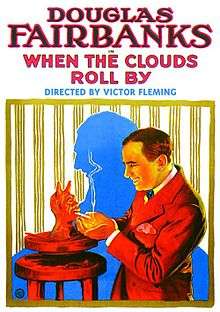When the Clouds Roll By
| When the Clouds Roll By | |
|---|---|
 Theatrical poster | |
| Directed by |
Victor Fleming Theodore Reed (uncredited) |
| Produced by | Douglas Fairbanks |
| Written by |
Douglas Fairbanks (story) T. J. G. (scenario) Lewis Weadon (uncredited) |
| Starring | Douglas Fairbanks |
| Cinematography |
William McGann Harry Thorpe |
| Distributed by | United Artists |
Release dates |
|
Running time | 50 minutes |
| Country | United States |
| Language | Silent (English intertitles) |
When the Clouds Roll By is a 1919 American comedy film starring Douglas Fairbanks and directed by Victor Fleming and Theodore Reed.[1][2] A copy of the film exists in an archive.[1]
Plot
As described in a film magazine,[3] Daniel Boone Brown (Fairbanks), a superstitious but ambitious young New Yorker, is the victim of demented psychiatrist Dr. Ulrich Metz (Grimwood) who, with the aid of numberless associates serving him in the interests of science, arranges circumstances intended to lead Daniel to suicide. In the midst of a series of bewildering misfortunes apparently emanating from broken mirrors, black cats, and similar sources, Daniel meets Greenwich Village artist Lucette Bancroft (Clifford), and mutual love results. A Westerner who owns land in partnership with Lucette's uncle comes to the city and plot's with Daniel's uncle Curtis (Lewis) to defraud his partner. Daniel, after being driven to the verge of suicide by the scientist and his aides, is saved when it is discovered that Dr. Metz is insane. Daniel then follows the Westerner, who has convinced Lucette to return to the west with him, when a flood engulfs the train they are riding on. Daniel brings about a happy resolution.
Cast
- Douglas Fairbanks as Daniel Boone Brown
- Kathleen Clifford as Lucette Bancroft
- Frank Campeau as Mark Drake
- Ralph Lewis as Curtis Brown
- Daisy Jefferson as Bobby De Vere
- Bull Montana as The Nightmare
- Herbert Grimwood as Dr. Ulrich Metz
- Albert MacQuarrie as Hobson
- Victor Fleming as Himself
- Thomas J. Geraghty as Himself (credited as T. J. G.)
- William C. McGann as Himself
- Harris Thorpe as Himself
- Babe London as Switchboard Operator (uncredited)
Reception
Fairbanks biographer Jeffrey Vance considers When the Cloud Rolls By to be the "best of all the contemporary Fairbanks comedies." "Executed at a breathless pace, When the Clouds Roll By is a masterful showpiece for the whirling cyclone of energy that was Douglas Fairbanks." Vance's highest praise is for the elaborate dream sequence, which he deems "a virtual encapsulation of every gymnastic feat in the Fairbanks repertoire" and notes that Fairbanks's walk on the ceiling of his home anticipates the celebrated "dancing on the ceiling" sequence in Stanley Donen's Royal Wedding (1951). Vance also notes that the film's flood sequence conclusion presages a similar ending in Buster Keaton's classic Steamboat Bill, Jr. (1928).[4]
The film is recognized by American Film Institute in these lists:
- 2002: AFI's 100 Years...100 Passions – Nominated[5]
References
- 1 2 Progressive Silent Film List: When the Clouds Roll By at silentera.com
- ↑ "When the Clouds Roll By". American Film Institute. afi.com. Retrieved 16 December 2015.
- ↑ "Reviews: When the Clouds Roll By". Exhibitors Herald. New York City: Exhibitors Herald Company. 10 (2): 61. January 10, 1920.
- ↑ Vance, Jeffrey. Douglas Fairbanks (Berkeley, 2008), 81-83 ISBN 978-0-520-25667-5.
- ↑ "AFI's 100 Years...100 Passions Nominees" (PDF). Retrieved 20 August 2016.
External links
| Wikimedia Commons has media related to When the Clouds Roll By. |
- When the Clouds Roll By at the Internet Movie Database
- When the Clouds Roll By synopsis at AllMovie
- Stills at silenthollywood.com
- Stills and commentary at JonathanRosenbaum.net